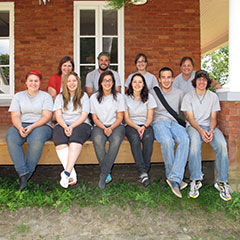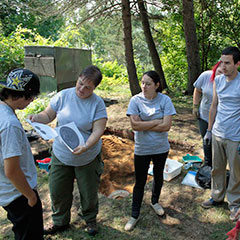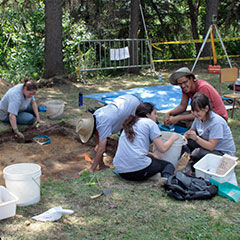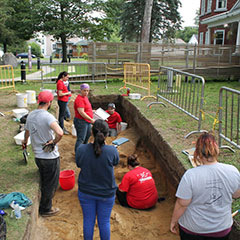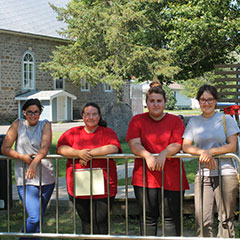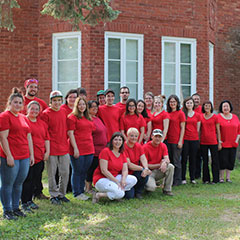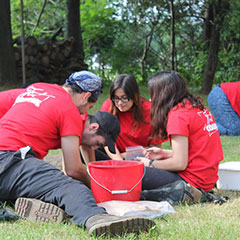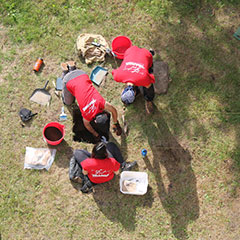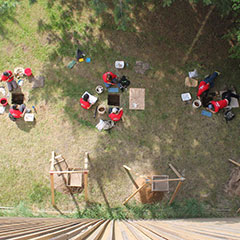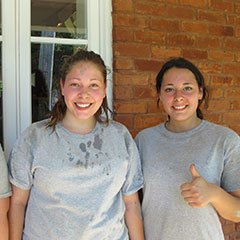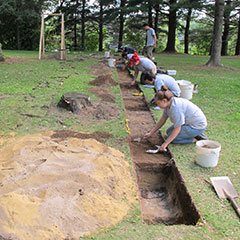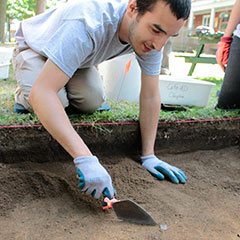Archaeology: it’s a Matter of Teamwork
The archaeological project Fort Odanak: the Past Revisited included a major educational component. The excavation team consisted of young students from the Abenaki community, assisted by two master’s students from the Université de Montréal and Université Laval. Two archaeologists, Geneviève Treyvaud and Michel Plourde, supervised the work.
The first week was devoted to training the master’s students and the apprentice diggers. The training provided them with general information about various topics, including archaeology, history, prehistory, work methods, archaeological equipment, technical drawing and artifact treatment. The master’s students and the apprentice diggers then prepared the excavation equipment while the archaeologists marked off with string the areas that were to be excavated. The archaeological fieldwork was about to begin...
Download video: MP4, (44,16 MB), WebM, (44,37 MB), Ogg (31,69 MB) (5 minutes 14 seconds)
Transcription
Julie Desaulniers: I’m with Geneviève Treyvaud, the archaeologist in charge of the dig at Fort Odanak. She’s going to tell us about the project.
First of all, what is Fort Odanak?
Geneviève Treyvaud: Fort Odanak is an early 17th-century fortification that was built by the King of France to protect his Abenaki allies. So it’s a fort that was a bit in the French style, you could say. It had a palisade and four bastions; plus the Abenaki village was located inside.
What is the Fort Odanak project?
G.T.: The Fort Odanak project is aimed at documenting this fortification that we know very little about. In fact, we know very little about the history of the Abenakis along the Saint-François River and their occupation of that area. We do know that around 1650 – this was documented by the Jesuits – that the Abenakis were present along the Saint-François River. But we don’t know what sites they occupied or how they lived. We have a plan of the fortification. In fact, the project began with a plan of the fortification made by Levasseur de Néré in 1704. It’s this plan that really made us say: “We have to do something on the Saint-François River. We have a good plan. We have to see if you can’t find that fortification.”
And so the archaeological dig began in 2012?
G.T.: Yes. Well, what actually happened is that in 2011 we started digging test pits, or small 50-cm squares just about everywhere here in Odanak in an effort to find archaeological remains that could be associated with the occupation of the fort. And then in 2012, after some of the test pits proved to be positive, we began to do an archaeological dig.
What are you looking for this year?
G.T.: Well, this year, since we knew that trying to find the entire palisade around the fort would involve an incredible amount of work and that several parts of the palisade would be missing because of work already done in the historic district, we decided that it would be preferable to really try and understand the interior of the fort by excavating the longhouse that we seem to have found here and that contains a number of pits. We wanted to try and understand how people lived day-to-day, what they ate, what they made, what their daily life was like, and what we call the “spatial organization” of the fort, or its interior layout. There was a fort here around 1706, but also a fortified mission, that is, a mission with a palisade, slightly earlier. And what’s interesting is that we’ve found not only 18th-century objects over there but also very interesting 17th-century layers. Therefore, we really cover the 17th and 18th centuries with the beads we’ve uncovered, but the beads are made from shells found along the coast of the United States, in the area of Maine, Boston, New-York, etc. We also discovered tools for making this type of bead. We found bone beads, as well as something extraordinary: two French gun flints made of silex that had been reworked into drills. It’s extremely rare to find that. We also have a few flakes that show that stone was worked here.
G.T.: We’ve started to find what might be called traces of pillars. So we now have three types of posts that are related to... different posts that are related to different structures inside the fortification. We really have pillars, that is, traces of pillars. We call them pillars because they have a diameter of 25 to 30 cm. And we have a kind of alignment over there. We find the traces at roughly between... at 4 m from each other. So we’re finding these pillars between 3 and 4 m from each other, and we think they’re part of the palisade. They’re large pillars, therefore structural pillars used to hold something that was very, very big in place. And next to them, we find these small posts driven into the sand, plus the posts... plus the posts that are associated with the longhouse – the longhouse that we’re excavating.

